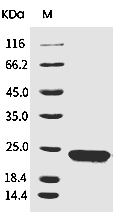Shopping Cart
Remove All Your shopping cart is currently empty
Your shopping cart is currently empty
KRAS Protein, Human, Recombinant (G12D, His) is expressed in E. coli expression system with His tag. The predicted molecular weight is 22 kDa and the accession number is P01116-2.

| Pack Size | Price | USA Warehouse | Global Warehouse | Quantity |
|---|---|---|---|---|
| 5 μg | $52 | 7-10 days | 7-10 days | |
| 10 μg | $81 | 7-10 days | 7-10 days | |
| 20 μg | $129 | 7-10 days | 7-10 days | |
| 50 μg | $255 | - | In Stock | |
| 100 μg | $450 | 7-10 days | 7-10 days | |
| 200 μg | $793 | 7-10 days | 7-10 days | |
| 500 μg | $1,670 | 7-10 days | 7-10 days |
| Biological Activity | Activity testing is in progress. It is theoretically active, but we cannot guarantee it. If you require protein activity, we recommend choosing the eukaryotic expression version first. |
| Description | KRAS Protein, Human, Recombinant (G12D, His) is expressed in E. coli expression system with His tag. The predicted molecular weight is 22 kDa and the accession number is P01116-2. |
| Species | Human |
| Expression System | E. coli |
| Tag | N-His |
| Accession Number | P01116-2 |
| Synonyms | RASK2,RALD,NS3,NS,K-RAS4B,K-RAS4A,K-RAS2B,K-RAS2A,KRAS2,KRAS1,K-RAS,Kirsten rat sarcoma viral oncogene homolog,KI-RAS,C-K-RAS,CFC2 |
| Construction | A DNA sequence encoding the human KRAS (P01116-2) (Thr2-Cys185, with natural variant Gly 12 Asp) was expressed with a polyhistidine tag at the N-terminus. Predicted N terminal: Met |
| Protein Purity | > 95 % as determined by SDS-PAGE.  |
| Molecular Weight | 22 kDa (predicted) |
| Endotoxin | < 1.0 EU/μg of the protein as determined by the LAL method. |
| Formulation | Lyophilized from a solution filtered through a 0.22 μm filter, containing 25 mM Tris, 100 mM glycine, 10% glycerol, pH 7.5. Typically, a mixture containing 5% to 8% trehalose, mannitol, and 0.01% Tween 80 is incorporated as a protective agent before lyophilization. |
| Reconstitution | A Certificate of Analysis (CoA) containing reconstitution instructions is included with the products. Please refer to the CoA for detailed information. |
| Stability & Storage | It is recommended to store recombinant proteins at -20°C to -80°C for future use. Lyophilized powders can be stably stored for over 12 months, while liquid products can be stored for 6-12 months at -80°C. For reconstituted protein solutions, the solution can be stored at -20°C to -80°C for at least 3 months. Please avoid multiple freeze-thaw cycles and store products in aliquots. |
| Shipping | In general, Lyophilized powders are shipping with blue ice. |
| Research Background | K-Ras belongs to the small GTPase superfamily, Ras family. Like other members of the Ras family, K-Ras is a GTPase and is an early player in many signal transduction pathways. It is usually tethered to cell membranes because of the presence of an isoprenyl group on its C-terminus. K-Ras functions as a molecular on/off switch. Once it is turned on it recruits and activates proteins necessary for the propagation of growth factor and other receptors' signal, such as c-Raf and PI 3-kinase. It binds to GTP in the active state and possesses an intrinsic enzymatic activity that cleaves the terminal phosphate of the nucleotide converting it to GDP. Upon conversion of GTP to GDP, K-Ras is turned off. The rate of conversion is usually slow but can be sped up dramatically by an accessory protein of the GTPase activating protein class, for example, RasGAP. In turn, K-Ras can bind to proteins of the Guanine Nucleotide Exchange Factor class, for example, SOS1, which forces the release of bound nucleotide. Subsequently, K-Ras binds GTP present in the cytosol and the GEF is released from ras-GTP. Besides essential function in normal tissue signaling, the mutation of a K-Ras gene is an essential step in the development of many cancers. Several germline K-Ras mutations are associated with Noonan syndrome and Cardio-Facio-Cutaneous syndrome. Somatic K-Ras mutations are found at high rates in Leukemias, colon cancer, pancreatic cancer, and lung cancer.Cancer ImmunotherapyImmune CheckpointImmunotherapyTargeted Therapy |
| Size | Quantity | Unit Price | Amount | Operation |
|---|

Copyright © 2015-2026 TargetMol Chemicals Inc. All Rights Reserved.